Whole Food Plant Based Diet and Fatty Liver Disease
If you've been toying with the idea of adopting a plant based diet after watching The Game Changers, you're certainly not the only one. For anyone yet to see the controversial documentary film, it follows former UFC fighter James Wilks as he travels the world interviewing a vast array of elite athletes (plus physicians, professors and scientists) who are proud to be powered by plants.
With powerlifting record holder Patrik Baboumian, Olympic silver medalist Dotsie Bausch, ultra-marathoner Scott Jurek, and even seven-time Mr. Olympia champion Arnold Schwarzenegger backing a plant based way of life on screen, the case for swapping turkey with tofu has never been quite so compelling.
Following the show's Netflix debut, Tour de France champion Chris Froome, Rocky star Dolph Lundgren, and professional bodybuilder Kai Greene have all switched to a plant based diet. Even Hafþór Júlíus Björnsson, a.k.a 'The Mountain' from Game of Thrones, said he'd consider giving it a crack. And now maybe you are, too?
Plant Based Diet: What Is It?
Following a plant based diet is about prioritising plants on your plate. Not just vegetables – though they're obviously a huge part of it – but all plant-derived foods, including "wholegrains, legumes, nuts, seeds and fruits, with few or no animal products," according to the British Dietetic Association (BDA).
Plant based is often used as social shorthand for 'vegan', but the BDA reckons veganism is just one example of a plant based diet. It says vegetarians and pescetarians (fish-eating veggies) also follow a plant based diet, as well as lacto-ovo vegetarians – who eat dairy foods and eggs but not meat, poultry or seafood – and even flexitarians, who eat meat or poultry only very occasionally.
So, unless your fridge looks like an abattoir or you survive exclusively on junk food, chances are you're halfway there already.
So, why bother? Well, while question marks loom over the purported health benefits of fad diets like keto, you'll be hard pushed to find a reputable dietician that warns against eating more fruits, veggies, wholegrains, pulses, nuts, seeds and so on. They're packed with a vast array of vitamins, minerals, antioxidants, flavanoids, phenols and fibre, which have been linked to cardiovascular, brain, metabolic, gut, immunity, inflammation and mood-boosting health benefits.
It's better for the planet, too. Animal agriculture (breeding, feeding and slaughtering cows, pigs, chickens, etcetera) emits more greenhouse gases than the entire transportation industry combined – that's every plane, car and train in the world – according to a United Nations report. But if everyone in the UK went plant based two days a week, the effect on CO2 levels would be equivalent to taking 54 per cent of cars off the road, all year, every year, calculations by Allplants revealed.
Rearing animals for food is also wasteful from a nutrition perspective. As it stands, 90 per cent of calories and proteins are grown to feed animals, but less than 10 per cent actually become consumable to us through meat, milk or eggs, Allplants found. And by ditching those products twice a week, you'll reduce your risk of heart disease by up to 20 per cent, as well as other nasties like high blood pressure, type 2 diabetes and obesity, they say.
Not Everything Plant Based Is Good for You...
However, that's not to say everything labelled 'plant based' is good for you (or the planet), especially when you're rummaging through faux meats in a mainstream supermarket. "Many vegan and vegetarian products can be classed as plant based but include a lot of processed sugar and excess salt," explains Rebecca Gold, nutritionist at Bark.com. "It's important to always check product labels for a full list of ingredients."
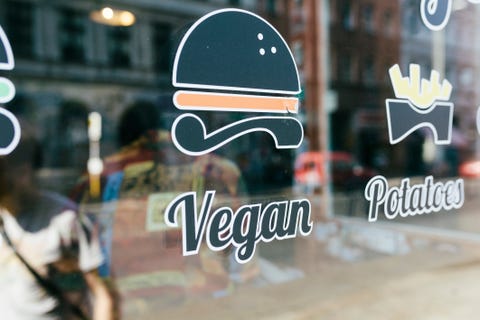
Hinterhaus Productions Getty Images
To an extent, it also depends precisely how plant based you intend your diet to be. "Despite the numerous health benefits associated with plant based foods, eating plants alone in place of entire food groups such as meat and dairy can quite rapidly result in nutritional deficiencies," explains Dr Warren Bradley, head of nutrition at Goal Master Fitness.
Diving right in might not do you any favours, but that's true of any diet, as online trainer and vlogger Jon Venus points out. "The most common deficiencies in vegans are the same deficiencies we see in people eating animal products, which means vitamin B12, vitamin D, and iron," he says. "Whether you follow a plant based diet or not, it is important to make a conscious decision to eat foods that contain these nutrients of concern."
Still, you need to make smart swaps – especially when it comes to nutrients like B12, creatine and omega 3 fatty acids, which are found almost exclusively in animal products, says Dr Bradley. "Others such as iron and calcium are found in small quantities in plants, but are significantly less bioavailable, which means they're less able to be absorbed by the body," he says.
But before you abandon this article and fire up the grill, hold tight, because there are ways to increase the bioavailability of certain nutrients. Take iron, for example. "If you combine iron-rich vegetables with foods high in vitamin C, the absorption increases exponentially," says Max Brunaccioni, vegan athlete and coach. "A well-planned plant based diet is as effective as any other diet – even for athletes."
This content is imported from Instagram. You may be able to find the same content in another format, or you may be able to find more information, at their web site.
Plant Based Protein: Building Muscle with Plants
The basic requirements for building muscle are quite simple, Dr Bradley outlines. You need to be in a caloric excess, eating enough protein for muscle recovery and plenty of carbohydrates for energy (for devoted carnivores, that might mean steak and potatoes or chicken with rice, he says). Loading up on colourful fruits and veggies, along with healthy fats and plenty of water, will optimise this process. But what if you want to scale back the animal element?
"If you've seen Game Changers, you'll have ingested plenty of information pertaining to the fact that you can grow monstrously huge and perform at an elite level on a plant based diet," Dr Bradley continues. "This is certainly true, but reflects a diet ticking all of the above boxes, which takes effort and discipline when plant based. That said, a plant based diet can be extremely healthy if you understand where to find the nutrients typically lacking from a plant only diet."
Protein – or rather, a distinct lack of it – is a cliché concern among those looking to adopt a plant based diet. It need not be. For starters, getting enough is easier than you think.
High protein plant based options include:
- peanuts
- almonds
- lentils
- chickpeas
- beans
- tofu
- edamame
- quinoa
- tempeh
Even potatoes, green peas and jackfruit contain the muscle macro. Protein accounts for 20 per cent of the calories in broccoli, which works out at around 3g in a 100g serving. Soy milk contains the same amount of protein as cow's milk, at 8g per 250ml.
But even more important is what the protein comes 'packaged' in. Gram for gram, raw red meat might boast more protein than chickpeas – around 20 to 24 grams per 100g, compared to 19g –but it also comes wrapped up in saturated fat and cholesterol. By comparison, chickpeas contain very little saturated fat, and eating one portion a day has been found to "significantly reduce" cholesterol, according to research published in the Canadian Medical Association Journal. With that said, chickpeas contain 61g of carbohydrates per 100g (17g of which are gut-boosting fibre) while red meat contains none. But that matters less than you think, Venus says.
This content is imported from Instagram. You may be able to find the same content in another format, or you may be able to find more information, at their web site.
"The main thing that changed when switching to a plant based diet was my macronutrient breakdown," he explains. "When you eat a lot of whole plant foods, you automatically eat more carbohydrates than if you were to eat animal products. Many people fear carbs, but not all carbs are equal. Eating refined sugar and candy isn't the same as eating carbohydrates from real foods like fruits, grains, and legumes.
"I was also automatically eating less protein, but I quickly realised that we don't need as much as people believe," Venus continues. "This was evident when my strength and muscle mass kept increasing over time on a slightly lower protein, plant based diet. My training methods – bodybuilding-style with high volume and frequency – and supplementation did not change at all, [since] I'd been using plant-based protein powders a while."
Here's what a typical day for Venus might look like – 2,200 kcals in total:
Breakfast
Porridge: 100g rolled oats, 200ml organic soy milk, 110g banana, 10g flaxseeds
Lunch
Lentil stew: 60g quinoa, 180g green lentils, 100g broccoli, 100g carrot, vegetable stock
Dinner
Burrito bowl: 40g brown basmati rice, 350g black beans, 200g sweet potato, 60g leafy greens, 50g avocado, 2tbsp salsa
Snack
Apple and nuts: 200g apple, 25g almonds
Protein shake: 30g vegan protein powder, 300ml unsweetened almond milk
Plant Based Diet: What to Eat Before Your Workout
Your body's primary fuel source is carbohydrates, which are digested and broken down into sugars that are transported by the blood to fuel working muscles," Dr Bradley explains. "The type of carbohydrate you choose should be considered in relation to time," he says, i.e. how long before your session you'll eat.
If you're fuelling up anywhere between 90 and 190 minutes prior to your workout – i.e. in the afternoon ahead of an evening workout – choose slow-digesting carb sources that provide a sustained energy release, like wholegrain pasta, wholegrain rice or white potatoes. Chickpea and quinoa mixed salad with avocado and balsamic dressing, for example, is a great pre-workout meal.
"Depending on the volume of your workout, you may wish to top up your energy with smaller quantities of quicker digesting carbs just before and during your exercise, such as fruit juice, pieces of fruit, raisins and breakfast bars," Dr Bradley advises.
When you're eating less than 90 minutes prior, you'll need fast-digesting carb sources to provide rapidly available energy, e.g. a peanut butter and banana sandwich made with white bread. "It's important to supplement carbohydrates with a protein source to stimulate muscle protein synthesis," he adds.
Plant Based Diet: What to Eat After Your Workout
When it comes to optimising muscle growth during recovery, there are two essentials elements to remember. Firstly, getting enough protein to repair the micro-tears in your muscles, and secondly, refuelling those muscles with the carbohydrates you've just burned through.
"Think of protein as bricks ready to be laid in a wall, and carbohydrates as builders working together to build the wall," says Dr Bradley. And don't overlook micronutrients, either. "Consuming antioxidant-rich foods will help to reduce the inflammation associated with exercise and help facilitate recovery," he says.
Now, there is a caveat. Plant based foods "typically contain less protein by weight and most contain incomplete protein, so a combination of foods and larger servings may be required to meet protein requirements, especially for those with a higher lean body mass," Dr Bradley continues.
Plant Based Diets and Amino Acids
To form a protein, 20 different amino acids bond together in a chain, of which 11 are produced by your body. Food is considered a complete protein when it contains the nine amino acids your body can't manufacture. Most complete proteins are animal based, except for soy – which means tofu, edamame, tempeh and miso are all complete plant based proteins.

OatmealStories Getty Images
'Incomplete protein', then, refers to foods that contain some, but not all, of these nine amino acids. However, by pairing two together – for example, beans and rice or peanut butter on wholewheat bread – you can make 'incomplete' proteins complete. You don't need to mix and match them at every meal, either. Getting a variety throughout the day is enough.
To increase muscle mass, you should aim to consume around 2g of protein per kilogram of body weight each day. For example, if you weigh 85kg, you should aim to eat around 170g protein throughout the day. "If you reach your needs by alternating the various protein foods – legumes, tofu, tempeh, seitan, cereals, etcetera – the protein problem does not exist," says Brunaccioni.
Essential Plant Based Kitchen Kit

BOSH! by Henry Firth and Ian Theasby
Harper Collins UK amazon.co.uk
£6.00

NutriBullet Veggie Bullet
NutriBullet amazon.co.uk
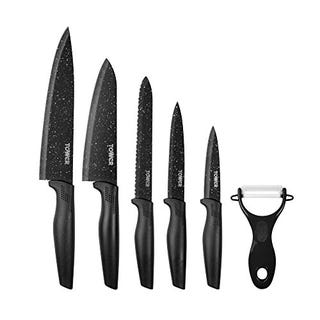
Tower Essentials Kitchen Knife Set
Tower amazon.co.uk

Stainless Steel Mixing Bowls with Airtight Lids
FineDine amazon.co.uk
£15.29
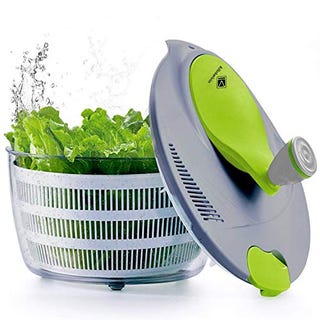
Kilokelvin Salad Spinner
Kilokelvin amazon.co.uk
£29.25
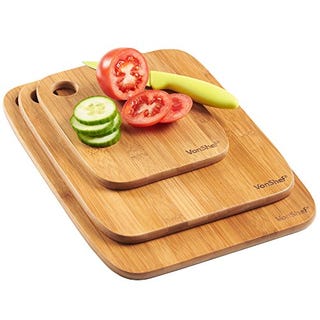
VonShef Bamboo Chopping Board Set
VonShef amazon.co.uk
£12.99
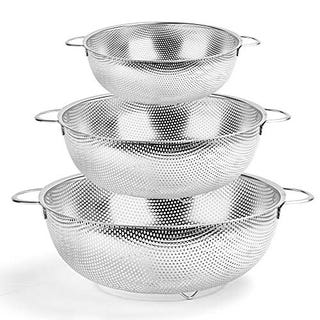
Metal Colander Set
HaWare amazon.co.uk
£16.99

Tefal Precision Plus StirFry Pan
Tefal amazon.co.uk
£38.00
Plant Based Recipes: The Best to Burn Fat and Build Muscle
Following a plant based diet tends to involve a fair bit of cooking, and while you shouldn't strictly need any extra kitchen kit, there are a few gadgets that'll make meal prep a little easier. A high-speed blender for smoothies, shakes and soups; glass food storage for leftover veggies; a salad spinner to rinse your spinach, etcetera.
"If I could only have one piece of kit and I wanted change from £100, I would buy an electric pressure cooker," says Healthspan nutritionist Nigel Mitchell, author of The Plant Based Cyclist. "They're essential for rice and grains. I put oats in every day before I go to bed, set the timer and wake up to delicious porridge. In the morning, I'll put in the ingredients for mixed bean chilli and it'll be ready when I get home."
Lentils With Maple and Cumin Roasted Carrots
By Justine Murphy, author of The mymuybueno Cookbook; serves four
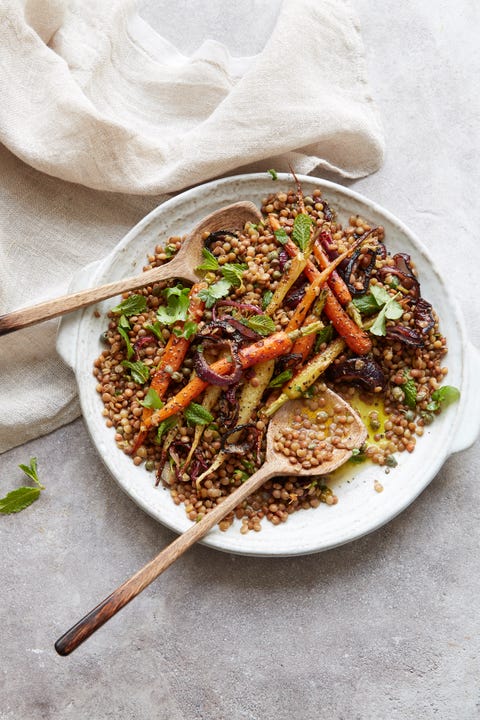
Ingredients:
(For the salad)
Carrots, 300g, quartered lengthways
Cumin seeds, 2 tsp
Olive oil, 2 tsp
Maple syrup, 3 tbsp
Sunflower oil, 1 tbsp
Garlic cloves, 2, peeled and sliced
Small red onion, 1, halved and thinly sliced
Brown lentils, 400g, cooked
Fresh coriander leaves, 20g, chopped
Fresh mint leaves, 20g, chopped
(For the dressing)
Garlic clove, 1, grated
Lemon, 1, zested and juiced
Capers, 2 tsp, drained
Olive oil, 2 tbsp
Sea salt flakes, pinch
Black pepper, grind
Method:
- Preheat the oven to 200°c. Add the carrot batons and cumin seeds to a large tin and drizzle over the olive oil.
- Roast for 20 minutes until cooked and starting to caramelise.
- Brush each piece of carrot well with the maple syrup then cook for a further 5 minutes.
- Meanwhile, heat sunflower oil in a frying pan with garlic and red onion and cook until softened.
- Add the cooked lentils and leave on the heat while stirring for a couple of minutes. Then pour the lentil mixture into a large serving bowl or platter and add the roasted carrots, coriander and mint, seasoning well.
- To make the garlic and caper dressing, stir the ingredients together in a small bowl or jug. Drizzle over the warm salad and finish with extra herbs and more black pepper.
Indian Black Bean and Red Lentil Dahl
By chefs Annabel Wray and Victoria Knight, co-founders of Hakuna Foods; serves two
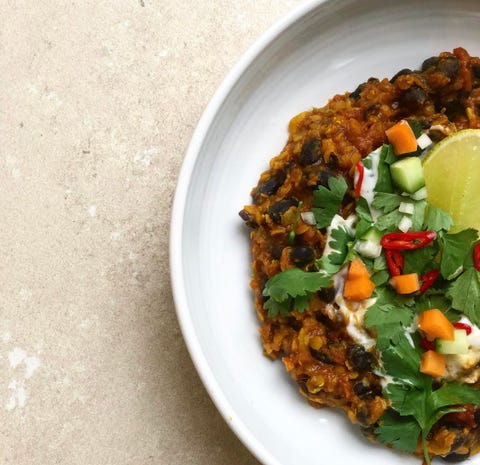
Ingredients:
Coconut oil, 3 tbsp
Onion, 1, finely diced
Garlic cloves, 3, grated
Ginger, 5cm, peeled and grated
Fresh turmeric finger, 1, peeled and grated
Curry leaf, 5
Freshly ground cumin, ½ tsp
Ground coriander, ½ tsp
Fenugreek seeds, 1 tsp
Salt, ½ tsp
Red cayenne powder, 1 tsp
Red lentils, 100g
Vegetable stock cube, 1
Water, 400ml
Black beans, 400g, drained and rinsed
Chopped tomatoes, 200g
Vegan yoghurt, 50g, to serve
Coriander, bunch, chopped, to serve
Method:
- Place a medium heavy-bottom pan on a medium heat. Add coconut oil and chopped onion and cook for 10 minutes, stirring regularly, until soft and starting to brown.
- Add garlic, ginger, turmeric, curry leaves, dry spices, and salt and pepper, and fry for 3 to 5 minutes, stirring constantly so the spices don't catch on the bottom of the pan.
- Add the lentils, tomato puree and stock cube, and stir to coat the lentils. Pour in the water and simmer on low heat for 15 minutes, stirring regularly.
- Add the black beans and chopped tomatoes and simmer for a further 15 minutes, stirring often until lentils are soft. If it looks too dry, add a little more water.
- To serve, spoon the dahl into a bowl and top with a spoonful of vegan yoghurt and a sprinkle of chopped coriander.
Quinoa and Jujube Stuffed Butternut Squash
Serves two

Ingredients:
Large butternut squash, 1/2, sliced lengthways
Red onion, 1
Garlic clove, 1
Vegetable stock cube, 1
White mushrooms, 3
Quinoa, 180g, uncooked
Jujube fruits, handful
Frozen peas, handful
Black pepper, to taste
Dried mixed herbs, to taste
Pomegranate seeds, to top (optional)
(For the dressing)
Tamari sauce, 1 tbsp
Tahini, 1 tbsp
Fresh lemon juice, 1 tbsp
Garlic clove, 1, crushed
Agave, 1 tbsp (optional)
Method:
- Preheat the oven to 190°c and slice the squash in half lengthways. Scoop the seeds out and place both halves on a baking tray. Bake for 50 minutes to 1 hour until very tender and caramelised.
- Place the quinoa into a saucepan and cover with 230ml water. Bring to the boil, then reduce the heat to a simmer. Crumble the stock cube in and cook until almost all of the water has been absorbed, then stir through with a fork and set aside.
- While the quinoa is cooking, finely dice the onion and crush the garlic. Heat a little oil in a frying pan and sauté both, before finely dicing the mushrooms and adding them to the pan with the frozen peas.
- Add the quinoa and toss the mix together before seasoning with a sprinkle of mixed herbs and black pepper.
- Finely chop the dried Jujube fruit and stir this through the mixture. Allow everything to cook for a few minutes.
- Once the squash halves are cooked, fill the centre of each with the quinoa mixture and pop back into the oven for 5 minutes.
- To make the dressing, combine the tahini, lemon juice, tamari sauce, garlic and agave, and mix well. Add water slowly, stirring continuously until the dressing is pourable.
- Serve the squash with pomegranate seeds, chopped jujube fruit and a drizzle of tahini dressing.
Gigantes Plaki
By chefs Annabel Wray and Victoria Knight, co-founders of Hakuna Foods; serves two
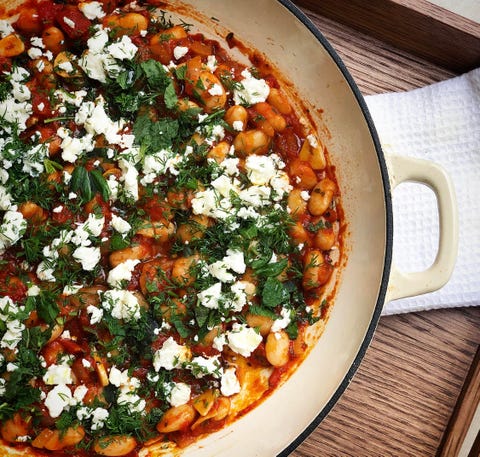
Ingredients:
Olive oil, 2 tbsp
Onion, 1, finely chopped
Garlic cloves, 3, thinly sliced
Dried oregano, 1 tbsp
Fresh thyme, 1 tbsp
Tomato puree, 1 tbsp
Butter beans, 400g, drained and rinsed
Chopped tomatoes, 400g
Oregano leaves, 2 sprigs
Vegan feta, 80g, crumbled,
Dill, ¼ pack, finely chopped
Mint leaves, 2 sprigs, finely chopped
Extra virgin olive oil, drizzle
Method:
- Place a large heavy-bottom pan on a medium heat. Add olive oil and chopped onion and cook for 10 minutes, stirring regularly, until soft and starting to brown.
- Add garlic and cook for another 3 minutes, stirring often, before adding dried oregano, fresh thyme, and tomato puree. Cook for another minute, stirring continuously.
- Add the butter beans, chopped tomatoes, fresh oregano, salt and pepper, and simmer on low heat for 15 to 20 minutes. Stir occasionally to make sure the bottom doesn't catch, but try not to squash the beans.
- To serve, sprinkle chopped herbs and vegan feta over the beans and finish with good drizzle of extra virgin olive oil.
Soutzoukakia Vegan Meatballs
By The Real Greek, Tower Bridge; serves six

Ingredients:
(Meatballs)
Vegan meat, 1kg
Spring onion, 150g, finely chopped
Mint, 7g, finely chopped
Dried Greek spice mix, 7g
Ground cumin, 2g
(Tomato sauce)
Chopped tomatoes, 400g
White onion, 750g
Extra virgin olive oil, 40ml
Salt, 5g
Black pepper, 3g
Garlic puree, 10g
Sweet paprika, 6g
Rosemary, 4g
Sage, 80g
Passata, 2kg
Bay leaf, 4g
Thyme, 4g
Method:
- Combine the vegan meat with the spring onion, mint, Greek spice mix and cumin. Mould into 30g portions with clean, oiled hands.
- Using a food processor, blitz the onion, garlic, rosemary and sage into a smooth paste.
- Place in a large pot with the chopped tomatoes, passata, bay leaf, thyme, water and salt and cook for 45 minutes.
- Once the sauce is cooked, add the paprika, extra virgin olive oil and black pepper and mix well.
- Cook the vegan meatballs on a medium heat grill for approximately 2 minutes each side, or until cooked. Then add to the hot tomato sauce with cumin. Simmer the vegan meatballs for 3 minutes and then serve.
Super Beet Burgers
By Spring Green London; serves six

Ingredients:
Raw beetroot, 4
Cooked chickpeas, 600g
Lime juice, ½
Cumin, 1 tsp
Chickpea flour, 1 tbsp
Quinoa, 50g, cooked
Red onion, 1, finely diced
Garlic clove, 1, crushed
Flaked salt, 1 tsp
Olive oil, 1 tsp
Pepper, to taste
Method:
- Preheat oven to 180°c. Heat oil in a frying pan and slowly cook onions until soft. After a few minutes add cumin and garlic and cook for a few more minutes.
- Grate raw beetroot in a food processor and remove half. Blend 300g chickpeas with the remaining beets until the consistency is thick and sticky.
- Transfer to a bowl and stir in the rest of the ingredients, including the onion mix, black pepper and salt. You may need to add extra chickpea flour if mixture is too wet, or some olive oil if too dry.
- Form the mixture into patties and place on an oiled baking tray. Cook for 30 to 40 minutes until firm and cooked through. Serve with sweet potato fries and black sesame broccoli.
Vegan Pancake
By Max Brunaccioni, vegan athlete and coach; makes 10

Ingredients:
Spelt flour, 100g
Rice flour, 50g
Natural soy yoghurt, 250g
Baking soda, ½ tsp
Instant yeast, 15g
Coconut milk, 250ml
Vinegar, ½ tbsp
Method:
- Mix the spelt and rice flour with instant yeast and baking soda.
- Add the coconut milk and yogurt and mix well.
- Leave to rest for 5 minutes, then add vinegar and mix.
- Heat a non-stick pan and pour some of the mixture into the pan with a large spoon.
- Cook for 3 to 4 minutes per side over a medium heat and garnish as you like.
Tempeh Curry with Lentils, Sweet Potatoes and Beetroots
By Max Brunaccioni, vegan athlete and coach

Ingredients:
Tempeh, 150g
Coconut oil, ½ tsp
Boiled beetroot, 1
Canned lentils, 150g
Sweet potato, 400g
Garlic clove, 1, crushed
Curry powder, ½ tsp
Smoked paprika, to taste
Salt and pepper, to taste
Method:
- Preheat the oven to 180°c. Chop the sweet potatoes, sprinkle with salt, pepper and paprika and bake for about 20 minutes.
- Cut the tempeh into small pieces and heat the coconut oil in a pan. Cook it for a few minutes, before adding a little water and curry powder.
- Season with salt and pepper and continue to cook for 4 to 5 minutes.
- Add the lentils in the pan with the garlic for a few minutes.
- Dice the boiled beetroot and serve.
Hungry for more plant based recipes? Below, you'll find a selection of veg-forward dishes from the MH archives...
This content is created and maintained by a third party, and imported onto this page to help users provide their email addresses. You may be able to find more information about this and similar content at piano.io
Whole Food Plant Based Diet and Fatty Liver Disease
Source: https://www.menshealth.com/uk/nutrition/a30118564/plant-based-diet/
0 Response to "Whole Food Plant Based Diet and Fatty Liver Disease"
Post a Comment